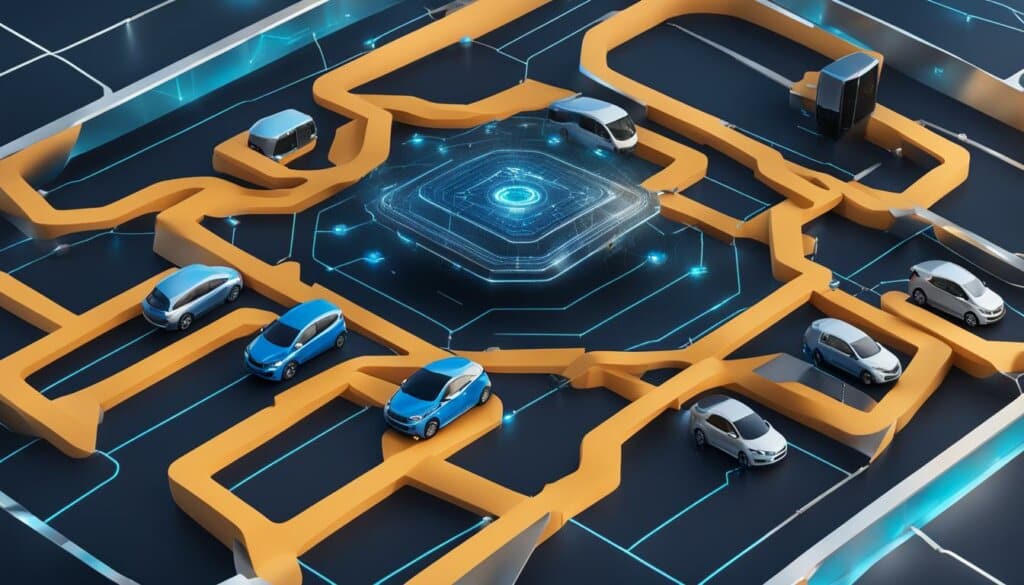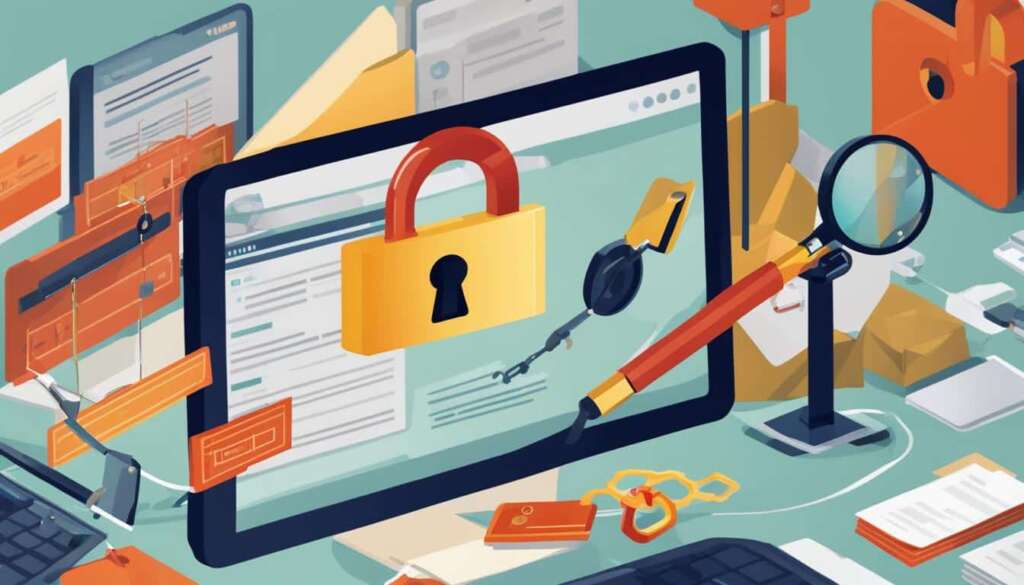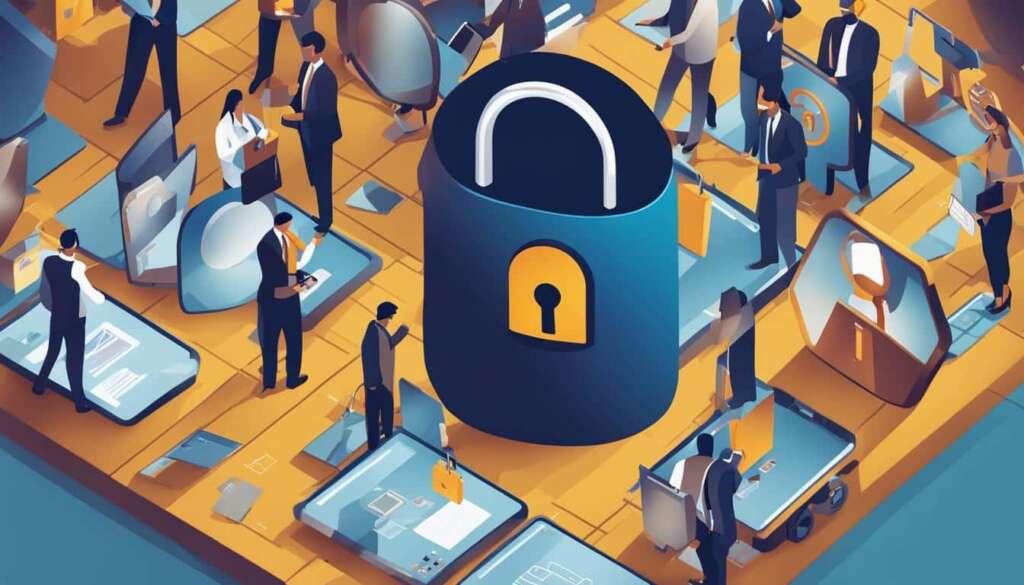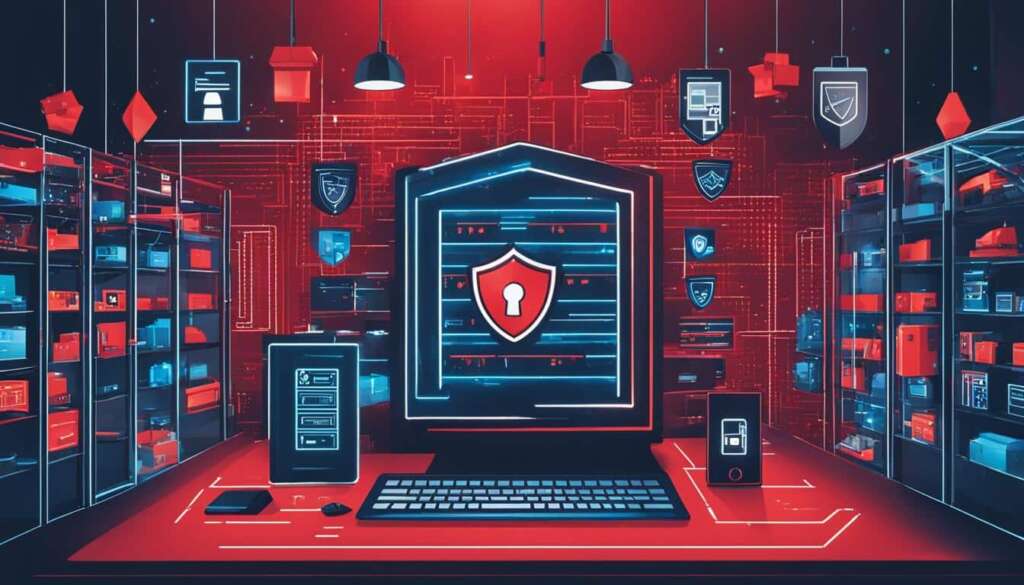Table of Contents
Welcome to our article on cybersecurity in the transportation sector. As our world becomes more interconnected, the transportation industry has embraced digital systems to enhance efficiency and connectivity. However, this increased reliance on technology also exposes the industry to cyber threats. In this article, we will explore the importance of transportation security and the challenges posed by cyber threats in the transportation sector.
As the transportation sector integrates digital systems, it becomes an attractive target for cybercriminals. The valuable data and interconnected nature of the industry make it susceptible to various cyberattacks, including malware attacks, ransomware attacks, denial-of-service attacks, and phishing attacks. According to Cybertalk.org, ransomware attacks on the transportation industry have increased by 186 percent between June 2020 and June 2021.
In the upcoming sections, we will delve deeper into the challenges faced by the transportation sector in cybersecurity, notable cyberattacks in the industry, and solutions to safeguard against these threats. We will also explore the role of government initiatives and the importance of cybersecurity in vehicle technology and transportation infrastructure.
Stay tuned to learn more about how the transportation industry can protect itself from digital threats and ensure the safety and efficiency of transportation networks.
Challenges in Transportation Cybersecurity
The transportation sector faces several challenges in cybersecurity. As technology becomes more prevalent in transportation operations, the vulnerability to cyberattacks increases. One challenge is the industry’s historical focus on safety and physical security rather than cybersecurity. Transportation companies often lack large security teams to protect their digital assets, making them more susceptible to cyber threats. Incorporating cyber defense strategies and practices into transportation systems is crucial to address these vulnerabilities.
Additionally, the interconnected nature of transportation systems poses another challenge. With multiple sectors, such as aviation, automobiles, maritime transportation, and railways, relying on interconnected digital systems, a breach in one sector could potentially impact others. This complexity makes it challenging to implement consistent cybersecurity measures across the entire transportation sector. Collaboration and coordination among different stakeholders, including government agencies, transportation companies, and cybersecurity professionals, are necessary to ensure a comprehensive approach to cybersecurity.
Furthermore, the rapid pace of technological advancements in the transportation sector presents a constant challenge in terms of keeping up with evolving cyber threats. As new technologies like autonomous vehicles and smart infrastructure are introduced, the attack surface for cybercriminals widens. Ensuring the security of these emerging technologies requires continuous monitoring, updating of security protocols, and staying informed about the latest cybersecurity trends and best practices.
Transportation Sector Vulnerabilities:
To better understand the vulnerabilities in the transportation sector, let’s take a closer look at some key areas:
- Legacy Systems: Many transportation systems still rely on outdated legacy systems that may not have been designed with modern cybersecurity threats in mind. These legacy systems may have inherent vulnerabilities that can be exploited by cybercriminals.
- Interconnected Networks: The interconnected nature of transportation systems, with various stakeholders sharing data and resources, increases the potential attack surface. A breach in one network could potentially spread to others, causing widespread disruption.
- Human Factors: Employees in the transportation sector may inadvertently fall victim to social engineering attacks or unknowingly introduce malware into the system. Cybersecurity awareness training and robust user access controls are essential to mitigate these risks.
- Supply Chain Vulnerabilities: The transportation sector relies heavily on supply chains, making it vulnerable to cyberattacks targeting suppliers or third-party vendors. Weak security measures within the supply chain can compromise the overall security of the transportation system.
Addressing these vulnerabilities and challenges requires a comprehensive approach that involves both technological and organizational measures. It is essential for transportation companies to make cybersecurity a priority, allocate resources to build robust security teams, and collaborate with industry partners and government agencies to develop and implement effective cyber defense strategies.
Notable Cyberattacks in the Transportation Sector
The transportation sector has been a target for cyberattacks, with several notable incidents highlighting the vulnerabilities within the industry. These attacks have had significant consequences, impacting global logistics, compromising critical infrastructure, and highlighting the need for strengthened cybersecurity measures.
The Maersk Cyberattack
In 2017, the Danish shipping company A.P. Moller-Maersk fell victim to a cyberattack that crippled its operations worldwide. The attack, carried out by the Petya ransomware, spread rapidly, affecting nearly 50,000 endpoints and disrupting Maersk’s shipping and logistics services. The incident resulted in significant financial losses and showcased the potential impact of cyber threats on transportation companies.
The MTA Cyberattack
The Metropolitan Transportation Authority (MTA) in New York City also experienced a notable cyberattack. Chinese threat actors targeted the MTA in a cyber-espionage campaign, gaining persistence on the agency’s computer systems. Although the extent of the breach was not fully disclosed, the incident raised concerns about the security of critical transportation infrastructure and highlighted the need for enhanced cybersecurity measures within the industry.
The Matson and ATC Transportation Cyberattacks
In recent years, both Matson, a global shipping company, and ATC Transportation, a logistics provider, fell victim to cyberattacks. Matson was targeted by cybercriminals using the Windows REvil ransomware, resulting in a disruption to its operations. ATC Transportation also experienced a similar incident involving a ransomware scam facilitated by malware installed on their servers. These attacks underscored the ongoing threats faced by transportation companies and emphasized the importance of robust cybersecurity defenses.
| Notable Cyberattacks in Transportation | Date | Impact |
|---|---|---|
| Maersk Cyberattack | 2017 | Significant disruption to global shipping and logistics services, financial losses |
| MTA Cyberattack | Year undisclosed | Concerns over the security of critical transportation infrastructure |
| Matson Cyberattack | Year undisclosed | Disruption to operations |
| ATC Transportation Cyberattack | Year undisclosed | Disruption due to ransomware attack |
These notable cyberattacks serve as a wake-up call for the transportation sector, highlighting the urgent need for robust cybersecurity measures. As the industry continues to rely on interconnected digital systems, it is crucial for transportation companies to prioritize cybersecurity and implement effective defenses to mitigate the potential impact of cyber threats. By staying vigilant, investing in cybersecurity resources and best practices, and collaborating with cybersecurity experts, the transportation sector can enhance its resilience and protect critical infrastructure from future attacks.

Solutions for Cybersecurity in the Transportation Sector
The transportation sector faces significant cybersecurity challenges due to its reliance on interconnected digital systems. To safeguard against digital threats and protect critical transportation infrastructure, various cybersecurity solutions can be implemented.
Improved Cybersecurity Education
One key solution is to enhance cybersecurity education within the transportation industry. By providing training and awareness programs, employees can gain a better understanding of cyber threats and learn best practices for safeguarding digital assets. This education can empower transportation professionals to identify and respond effectively to potential cyberattacks.
Collaboration and Partnerships
Collaboration between educational institutions, cybersecurity professionals, and transportation industry stakeholders is crucial for developing effective cybersecurity solutions. By working together, these entities can share knowledge, resources, and expertise to strengthen cyber defenses and stay ahead of evolving threats. Partnerships can also facilitate the development of industry-specific cybersecurity frameworks and standards.
Secure Communication Networks
Securing communication networks is another vital aspect of cybersecurity in the transportation sector. Implementing advanced encryption and authentication protocols can prevent unauthorized access to sensitive data and ensure the integrity of communication channels. Regular audits and assessments of network infrastructure can help identify vulnerabilities and implement necessary patches and updates.
| Cybersecurity Solutions for Transportation | Benefits |
|---|---|
| Implementing robust access controls | Prevents unauthorized access to critical systems and data |
| Regular vulnerability assessments and penetration testing | Identifies weaknesses in systems and allows for proactive remediation |
| Establishing incident response plans | Enables rapid and effective response to cyber incidents |
| Implementing multi-factor authentication | Enhances the security of user credentials and access |
By implementing these cybersecurity solutions, the transportation sector can enhance its resilience against cyber threats, protect critical infrastructure, and maintain the safety and efficiency of transportation networks.
The Importance of Cybersecurity in the Transportation Industry
Ensuring the cybersecurity of the transportation industry is of utmost importance to safeguard against digital threats and protect critical infrastructure. With the increasing reliance on interconnected digital systems, it is crucial to prioritize cybersecurity to maintain the safety, efficiency, and integrity of transportation networks.
The transportation industry plays a critical role in the economy and national security, making it an attractive target for cybercriminals. Safeguarding transportation systems is essential to ensure uninterrupted operations, protect valuable data, and prevent potential disruptions to the global supply chain. The consequences of a successful cyberattack on transportation networks could be catastrophic, impacting not only the industry but also the wider economy and public safety.
By prioritizing cybersecurity in the transportation industry, companies can mitigate risks and stay ahead of evolving cyber threats. Implementing robust cybersecurity solutions, incorporating cyber defense strategies, and investing in cybersecurity education and collaboration are key steps in safeguarding transportation systems. Collaboration between educational institutions, cybersecurity professionals, and transportation industry stakeholders can help develop effective security concepts and practices tailored to the unique challenges of the industry.
Table: Cybersecurity Measures for the Transportation Industry
| Cybersecurity Measure | Description |
|---|---|
| Improved Education and Training | Enhancing cybersecurity education and training programs to build a skilled workforce capable of addressing emerging cyber threats in transportation. |
| Cyber Defense Strategies | Developing and implementing robust cyber defense strategies to protect transportation systems from cyberattacks and mitigate vulnerabilities. |
| Collaboration and Information Sharing | Encouraging collaboration and information sharing between industry stakeholders, government agencies, and cybersecurity professionals to enhance the collective ability to detect, respond to, and recover from cyber incidents. |
| Securing Critical Infrastructure | Implementing measures to secure critical transportation infrastructure, including manufacturing facilities, communication networks, and control systems. |
| Regulatory Compliance | Complying with relevant regulations and standards, such as the NIST Cybersecurity Framework and industry-specific guidelines, to ensure a minimum level of cybersecurity readiness. |
“The transportation industry must recognize the importance of cybersecurity and take proactive measures to safeguard against digital threats. Cyberattacks can have far-reaching consequences, impacting not only individual companies but also the entire transportation ecosystem. By investing in cybersecurity measures and fostering collaboration, the industry can enhance its resilience and protect critical infrastructure.” – Cybersecurity Expert
Government Initiatives for Transportation Cybersecurity
The government is actively involved in addressing cybersecurity in the transportation sector, particularly through initiatives led by the U.S. Department of Transportation (USDOT). These initiatives aim to ensure the security of federal transportation systems and protect against cyber threats.
Under the USDOT, various research programs focus on different aspects of transportation cybersecurity. These programs include efforts to enhance vehicle cybersecurity, secure infrastructure, protect DSRC (Dedicated Short-Range Communications) communications, and establish security standards for ITS (Intelligent Transportation Systems) architecture. The USDOT collaborates with modal agencies, federal organizations, industry partners, and academic institutions to develop and implement unified approaches to cybersecurity.
The government’s initiatives recognize the interconnected nature of transportation systems and the need for comprehensive cybersecurity measures. By integrating cybersecurity practices into transportation systems and establishing security standards, the government aims to enhance the resilience of transportation infrastructure and minimize vulnerabilities to cyber threats.
“The government’s initiatives recognize the interconnected nature of transportation systems and the need for comprehensive cybersecurity measures.”
The Benefits of Government Initiatives
Government initiatives play a crucial role in driving awareness about cybersecurity risks and fostering collaboration between key stakeholders. By actively engaging with industry experts, academia, and transportation agencies, the government can leverage collective expertise to develop effective strategies and solutions.
- Increased cybersecurity awareness: Government initiatives raise awareness about the importance of cybersecurity in the transportation sector, ensuring that stakeholders prioritize security measures.
- Collaboration and knowledge sharing: By fostering collaboration between industry, academia, and government agencies, initiatives enable the sharing of best practices, research findings, and emerging technologies.
- Standardization and regulation: Government initiatives facilitate the development of security standards and regulations that contribute to a more secure and resilient transportation ecosystem.
Overall, government initiatives establish a framework for addressing cybersecurity challenges in the transportation sector and pave the way for a safer and more secure future.

Cybersecurity in Vehicle Technology
As vehicles become more technologically advanced, the need for cybersecurity in the automotive industry has become increasingly crucial. The integration of connected vehicles and autonomous cars has introduced a new set of cybersecurity challenges that need to be addressed to ensure the safety and security of these vehicles.
One of the main concerns is the potential for vehicle cyber threats. Hackers can target high-speed communication systems, software, and hardware suppliers, exploiting vulnerabilities in vehicle security. A well-known example of this is the 2015 Jeep Cherokee hack, where hackers were able to remotely control the vehicle’s systems, including the brakes and steering.
To secure connected vehicles, manufacturers and automotive companies need to implement robust cybersecurity measures. This includes securing vehicle systems from unauthorized access, data breaches, and manipulation. It also involves establishing secure communication protocols between connected vehicles and infrastructure.

Cybersecurity in Transportation Infrastructure
In today’s digital era, ensuring robust cybersecurity in transportation infrastructure is of paramount importance. With the increasing reliance on interconnected systems and the rise of smart technology, securing roadside equipment and devices has become crucial to protect against cyber threats. The transportation sector, including roadways, bridges, tunnels, and traffic control systems, faces the constant challenge of safeguarding critical infrastructure from potential cyberattacks.
One of the main objectives in securing transportation infrastructure is mitigating the risk of unauthorized access, data breaches, and manipulation of critical systems. The Federal Highway Administration (FHWA) has taken a proactive approach to improve cyber resilience in surface transportation infrastructures. By developing outreach programs, awareness efforts, and tools, the FHWA aims to help transportation agencies better understand and mitigate cybersecurity risks.
The cyber threats facing transportation infrastructure are diverse and ever-evolving. From ransomware attacks targeting traffic management systems to phishing attempts aimed at gaining unauthorized access to critical devices, the risks are significant. Customizing risk mitigation materials and expanding the analysis of additional risks resulting from increased connectivity between vehicles and infrastructure are key priorities in ensuring the security of transportation infrastructure.
| Common Cyber Threats to Transportation Infrastructure | Impact |
|---|---|
| Ransomware attacks | Disruption of traffic control systems and infrastructure operations. |
| Phishing attempts | Potential unauthorized access to critical devices and infrastructure. |
| Malware infections | Compromise of sensitive data and disruption of operations. |
| Distributed Denial of Service (DDoS) attacks | Overwhelming network resources, leading to service outages. |
The cybersecurity measures implemented in transportation infrastructure must be comprehensive and proactive. Collaborative efforts between government agencies, transportation authorities, and cybersecurity experts are critical to identifying vulnerabilities, implementing robust security frameworks, and conducting regular assessments to stay ahead of emerging threats. By prioritizing cybersecurity in transportation infrastructure, we can ensure the reliability, safety, and integrity of our critical transportation systems.
Ensuring Security in Connected Vehicles
Security in connected vehicles is of paramount importance to protect against cyber threats and safeguard the integrity of transportation systems. As technology advances, vehicles are becoming increasingly interconnected, creating a larger attack surface for hackers to exploit. To ensure the safety and privacy of connected vehicles, it is crucial to establish robust standards and architecture that prioritize security.
The connected vehicle architecture and standards developed by the U.S. Department of Transportation (USDOT) play a vital role in implementing security measures. These standards aim to build end-to-end security into connected vehicle systems, components, and communications. By incorporating encryption and certificate management methods, the USDOT’s system architecture ensures secure communication and validates safety and mobility messages.
Connected vehicle architecture and standards are essential for establishing a secure and trusted environment for connected vehicles. These standards provide a framework for implementing security measures that protect against unauthorized access, data breaches, and manipulation.
Implementing connected vehicle security requires collaboration between industry experts, government agencies, and other stakeholders. It is crucial to adopt and adhere to the established architecture and standards to ensure uniform and effective security measures across the connected vehicle ecosystem. By prioritizing security in the design and operation of connected vehicles, we can protect both the technology and the passengers who rely on it.

Table: Key Elements of Connected Vehicle Architecture and Standards
| Element | Description |
|---|---|
| Secure Communication | Encryption and certificate management methods to facilitate secure communication between vehicles and infrastructure. |
| Authentication | Verification of the identity and legitimacy of connected vehicles, components, and communications. |
| Privacy | Protection of the personal data and privacy of vehicle occupants. |
| Data Integrity | Ensuring the accuracy and reliability of data transmitted between vehicles and infrastructure. |
| Access Control | Prevention of unauthorized access to connected vehicle systems and functions. |
By implementing robust security measures and adhering to established standards, the transportation industry can enhance the safety and reliability of connected vehicles. Continued collaboration and investment in security research and development will be essential to stay ahead of evolving cyber threats and ensure a secure connected transportation environment.
The Role of Security Credential Management System (SCMS)
The Security Credential Management System (SCMS) plays a vital role in ensuring trusted communications between vehicles and infrastructure in the transportation sector. Developed through a collaboration between the automotive industry and security experts, the SCMS utilizes innovative encryption and certificate management methods to facilitate secure communication.
“The SCMS is a significant milestone in enhancing the security of connected vehicles. Through its robust authentication and validation processes, it enables the secure transmission of safety and mobility messages, ensuring the integrity of the connected vehicle system,” says Dr. Jane Williams, a leading cybersecurity expert in the transportation sector.
Digital certificates issued by the SCMS authenticate and validate safety and mobility messages in the connected vehicle system, preventing unauthorized access and manipulation. These certificates serve as digital credentials that establish trust and enable secure communication between vehicles and infrastructure.
The operations of the SCMS involve the issuance, revocation, and management of these digital certificates. Ownership and governance models are necessary to deploy and oversee the SCMS effectively, ensuring its integrity and reliability. Ongoing collaboration between industry stakeholders, government agencies, and cybersecurity professionals is crucial in maintaining the SCMS’s operations and continually enhancing its security features.
Overview of SCMS Operations
| Operation | Description |
|---|---|
| Certificate Issuance | The SCMS issues digital certificates to connected vehicles and infrastructure, providing them with unique digital identities. |
| Revocation Management | The SCMS handles the revocation of certificates in case of security breaches or compromised digital identities, ensuring the trustworthiness of the system. |
| Certificate Renewal | As certificates expire over time, the SCMS facilitates the renewal process, ensuring uninterrupted secure communication between connected vehicles and infrastructure. |
| Key Management | The SCMS manages encryption keys used for securing communication channels, preventing unauthorized access and protecting the confidentiality of data exchanged. |
The Security Credential Management System (SCMS) is an integral component in securing communications in the transportation sector. By providing trusted digital certificates and facilitating secure communication between vehicles and infrastructure, the SCMS plays a crucial role in safeguarding the integrity and reliability of the connected vehicle system.
Conclusion
In conclusion, cybersecurity plays a critical role in safeguarding the transportation sector against the ever-evolving digital threats it faces. With the industry’s increasing reliance on interconnected digital systems, it becomes more vulnerable to cyberattacks. By implementing cybersecurity solutions and strategies, the transportation sector can mitigate these risks and protect its critical infrastructure.
Collaboration between educational institutions, cybersecurity professionals, and industry stakeholders is vital in developing robust security concepts and practices. Prioritizing cybersecurity education and raising awareness about cyber threats will help build a resilient transportation industry. Governments, such as the U.S. Department of Transportation, are taking proactive measures to address cybersecurity in the sector through research programs and initiatives.
Securing vehicle technology, transportation infrastructure, and connected vehicles is of utmost importance. The industry must ensure the safety, efficiency, and integrity of transportation networks by investing in cybersecurity measures. By doing so, the transportation sector can continue to fulfill its crucial role in the economy and national security, while protecting valuable data and preventing potential disruptions to the global supply chain.
FAQ
What are the common cyberattacks in the transportation sector?
The common cyberattacks in the transportation sector include malware attacks, ransomware attacks, denial-of-service attacks, and phishing attacks.
How has the number of ransomware attacks in the transportation industry changed?
According to Cybertalk.org, the number of weekly ransomware attacks on the transportation industry increased by 186 percent between June 2020 and June 2021.
Why is the transportation sector vulnerable to cyberattacks?
The transportation sector is vulnerable to cyberattacks due to its valuable data, interconnected nature, and reliance on technology.
What challenges does the transportation sector face in cybersecurity?
The transportation sector faces challenges in cybersecurity due to its historical focus on safety and physical security rather than cybersecurity, and the lack of large security teams to protect digital assets.
What are the notable cyberattacks in the transportation sector?
Notable cyberattacks in the transportation sector include the ransomware attack on A.P. Moller-Maersk, the cyber-espionage campaign targeting the Metropolitan Transportation Authority (MTA), the Windows REvil ransomware attack on Matson, and the ransomware scam on ATC Transportation.
What are the solutions for cybersecurity in the transportation sector?
The solutions for cybersecurity in the transportation sector include cybersecurity education, collaboration between educational institutions and industry stakeholders, and the development and implementation of robust security concepts throughout transportation systems.
Why is cybersecurity important in the transportation industry?
Cybersecurity is important in the transportation industry to ensure uninterrupted operations, protect valuable data, and prevent potential disruptions to the global supply chain.
What government initiatives are in place for transportation cybersecurity?
The U.S. Department of Transportation (USDOT) has research programs dedicated to ensuring a secure connected transportation environment, focusing on vehicle cybersecurity, infrastructure cybersecurity, DSRC communications security, and ITS architecture and standards security.
What are the cybersecurity challenges in vehicle technology?
Vehicle technology presents unique cybersecurity challenges, including the extensive attack surface introduced by connected vehicles and autonomous cars, vulnerabilities posed by high-speed communication systems and software, and hardware suppliers.
How is cybersecurity addressed in transportation infrastructure?
The Federal Highway Administration (FHWA) is working to improve the cybersecurity resilience of surface transportation infrastructures by developing outreach, awareness efforts, and tools to help transportation agencies understand and mitigate cybersecurity risks.
How is security ensured in connected vehicles?
Security in connected vehicles is ensured through the development of system architecture and voluntary consensus standards that aim to build uniform, end-to-end security in the connected vehicle environment, protecting the integrity and privacy of data transmitted throughout the ecosystem.
What is the role of the Security Credential Management System (SCMS) in transportation cybersecurity?
The Security Credential Management System (SCMS) facilitates trusted communications between vehicles and infrastructure by using innovative encryption and certificate management methods to authenticate and validate safety and mobility messages in the connected vehicle system.
Source Links
- https://cybersecurityguide.org/industries/transportation/
- https://www.its.dot.gov/factsheets/pdf/cybersecurity_factsheet.pdf
- https://envistacorp.com/blog/navigating-cyber-security-transportation-logistics/













